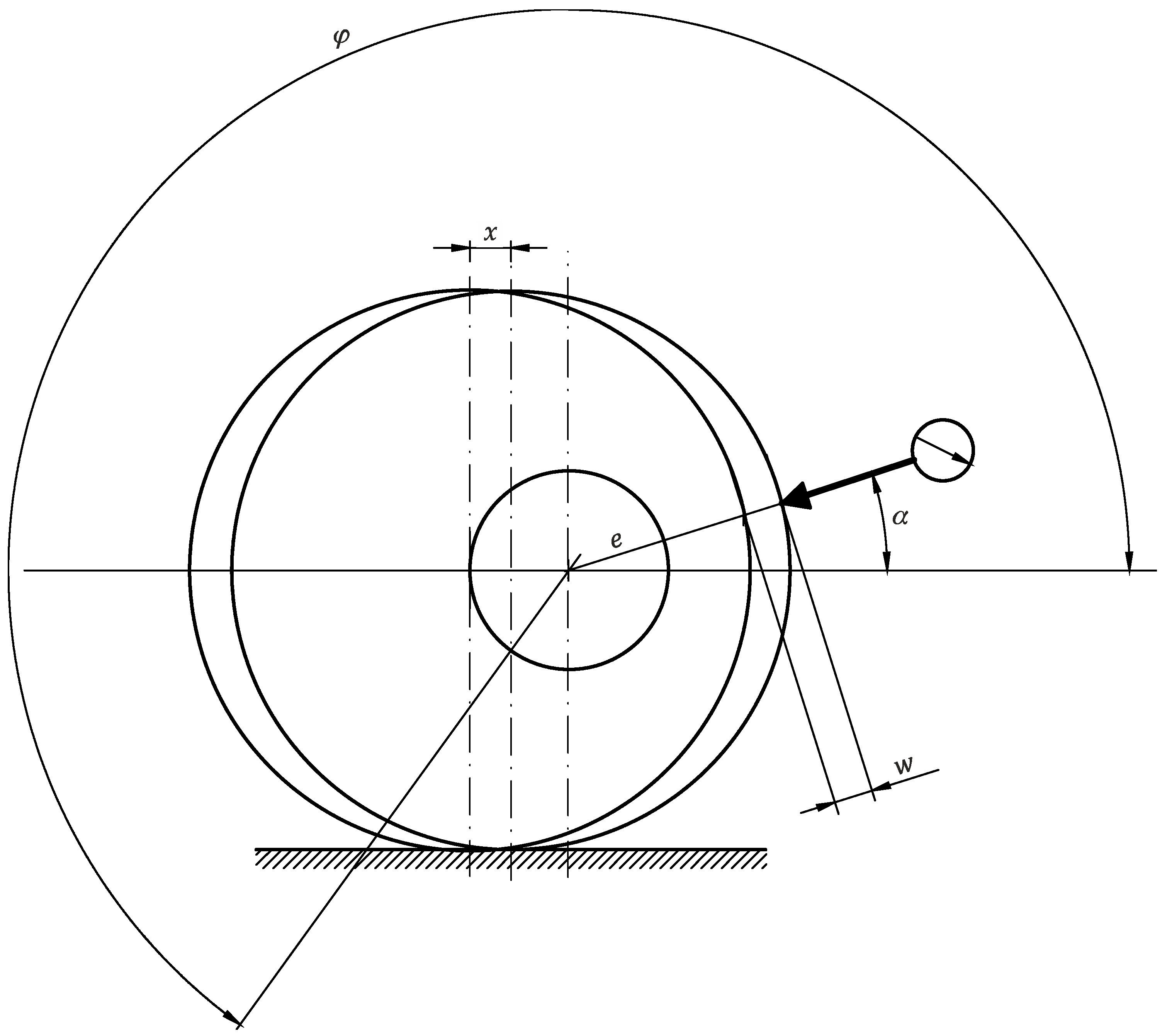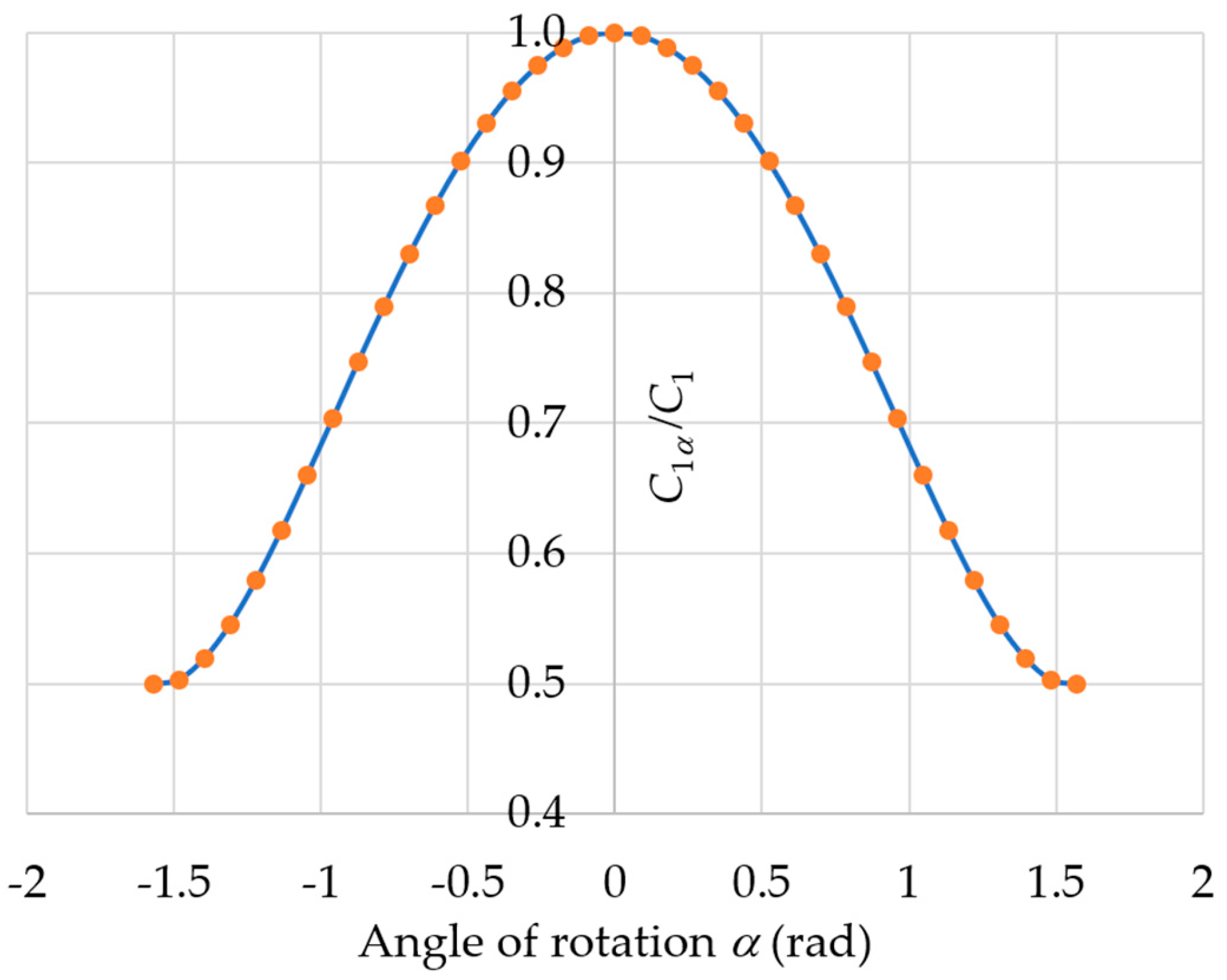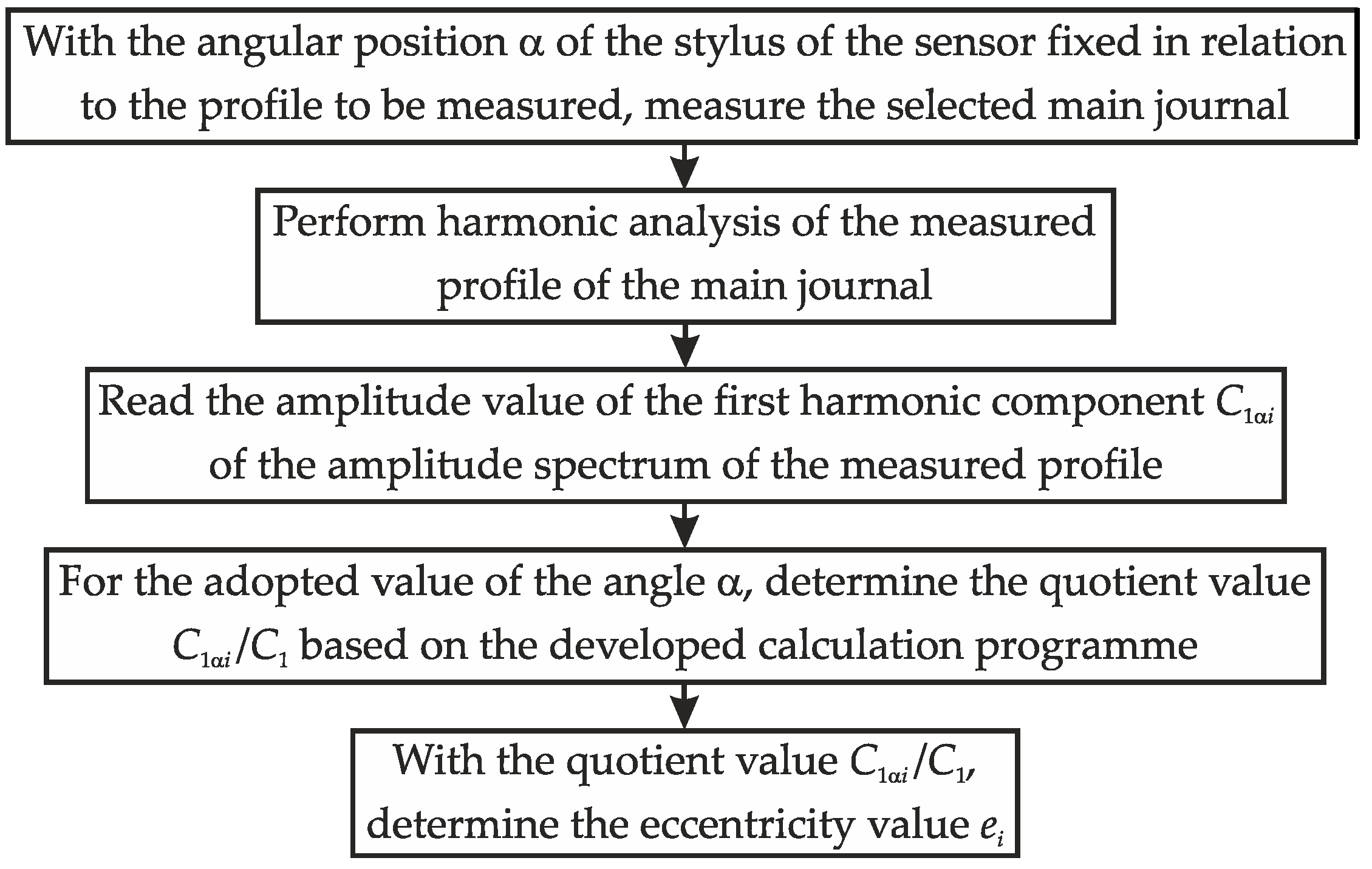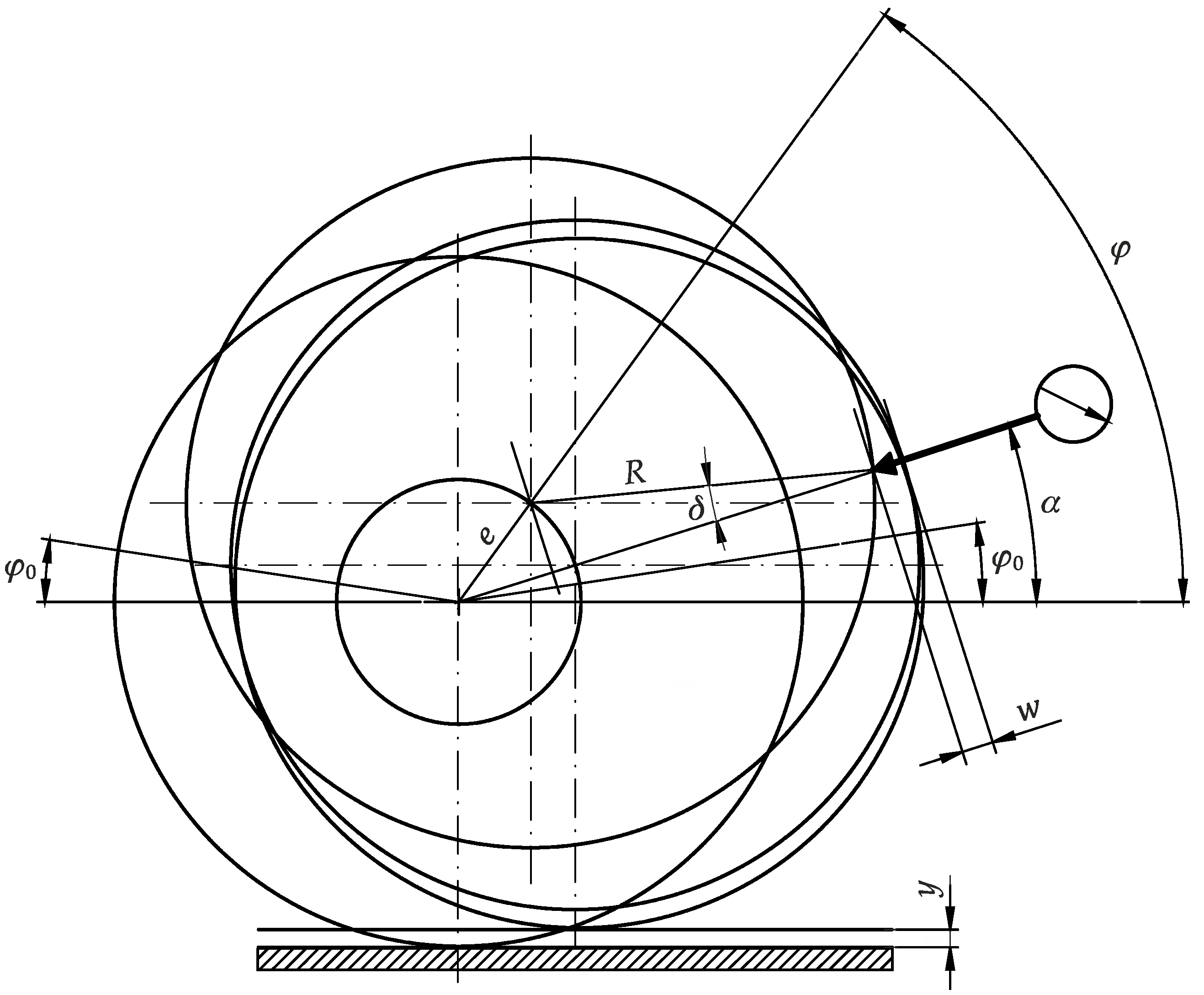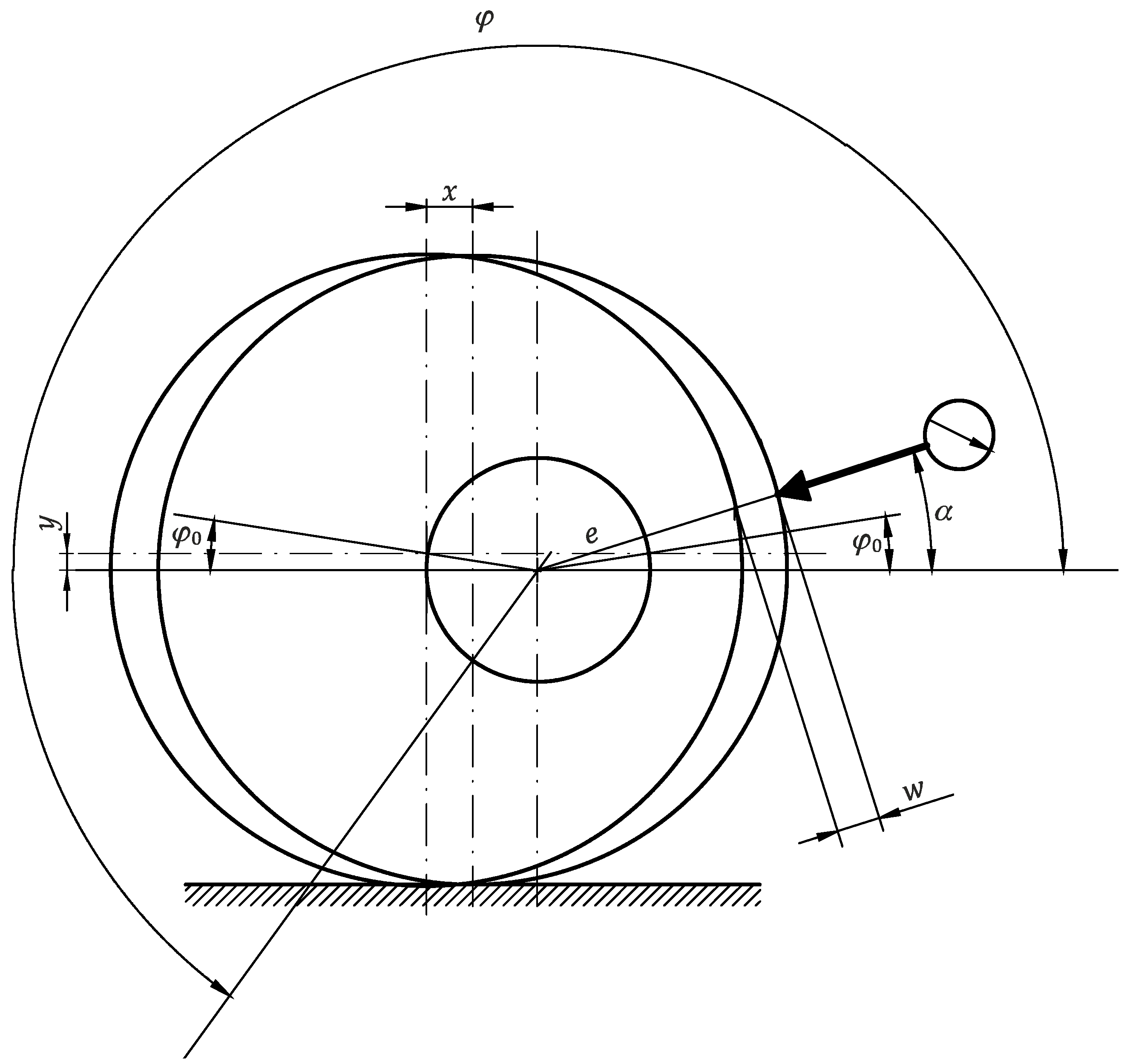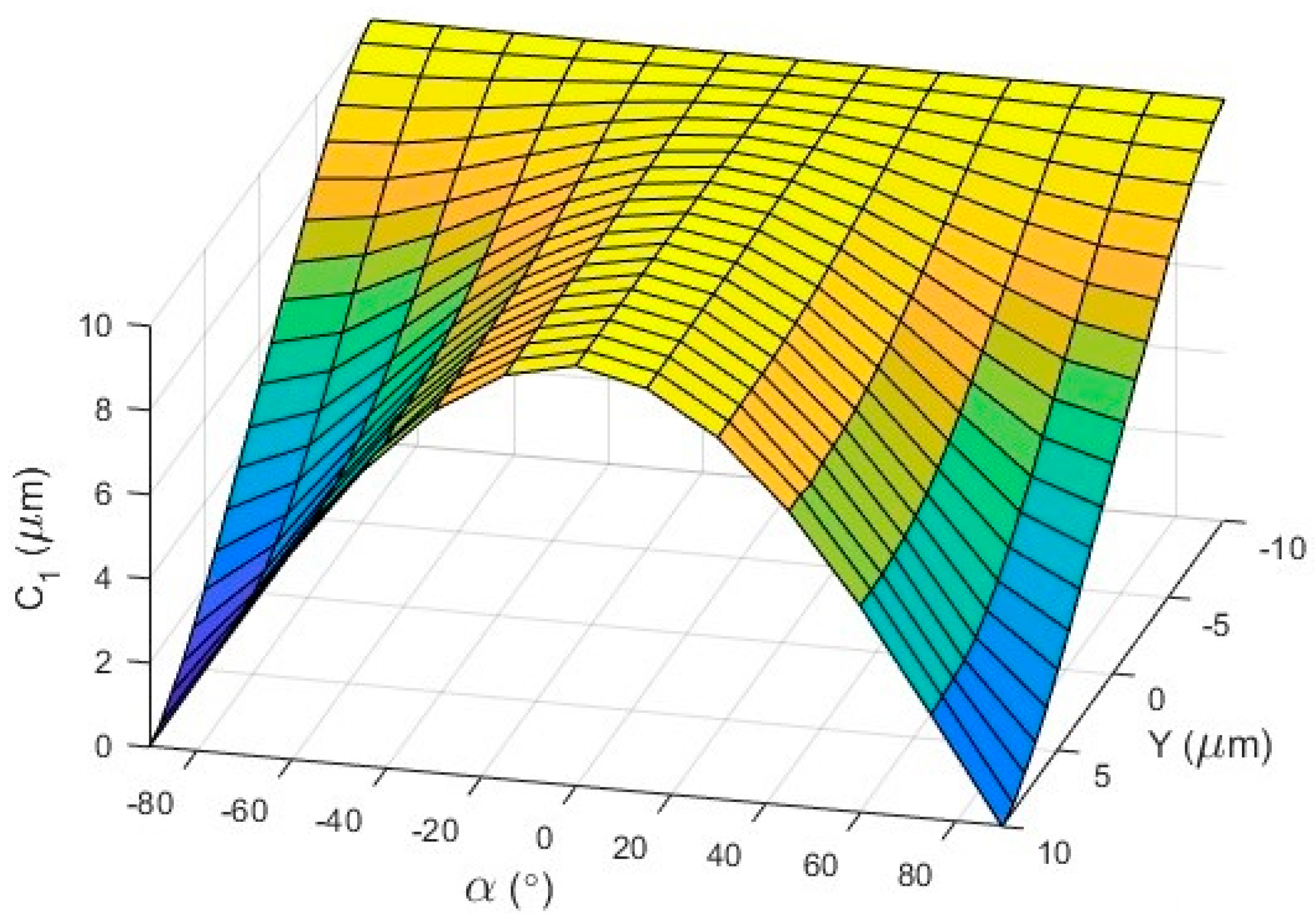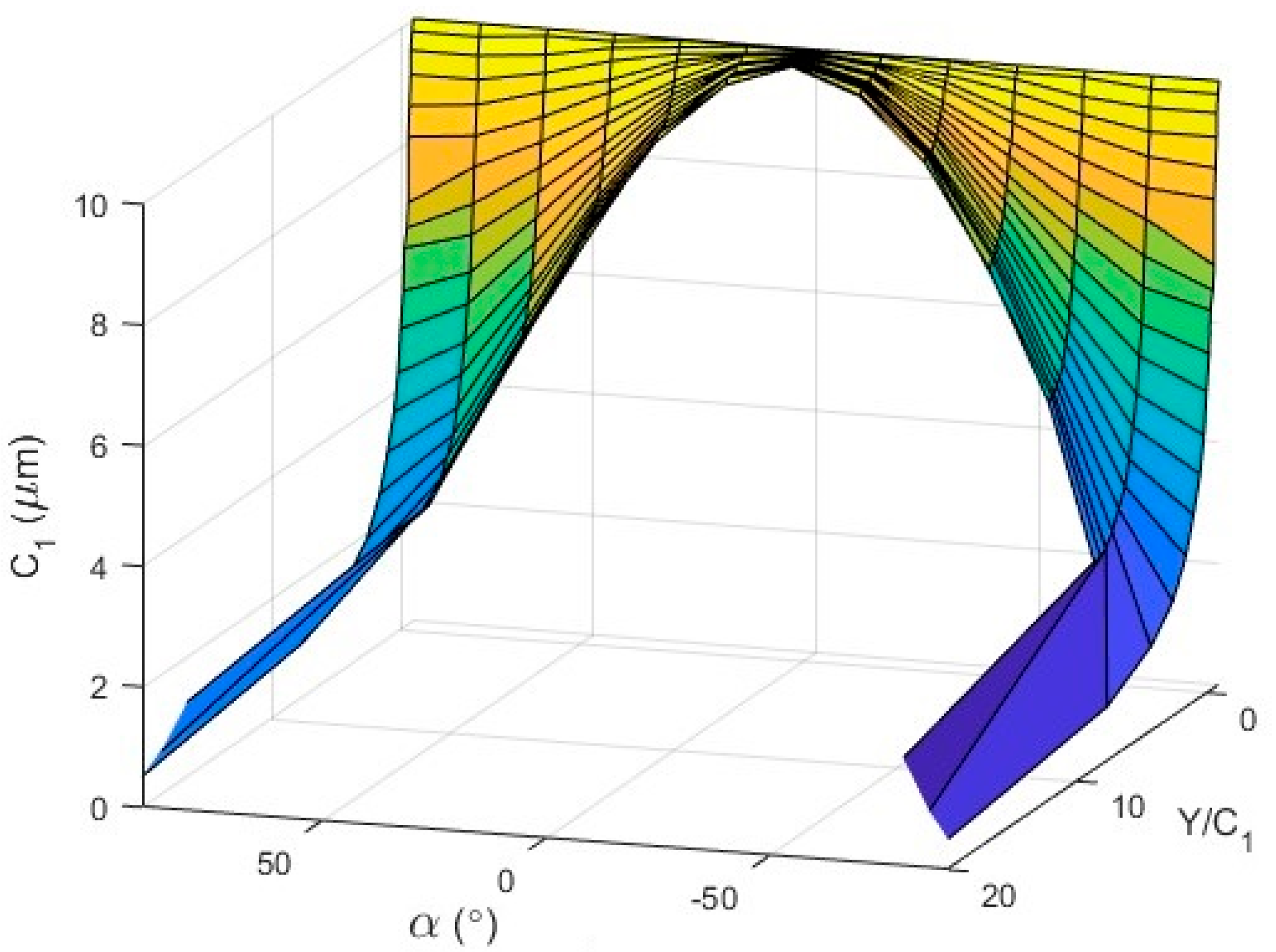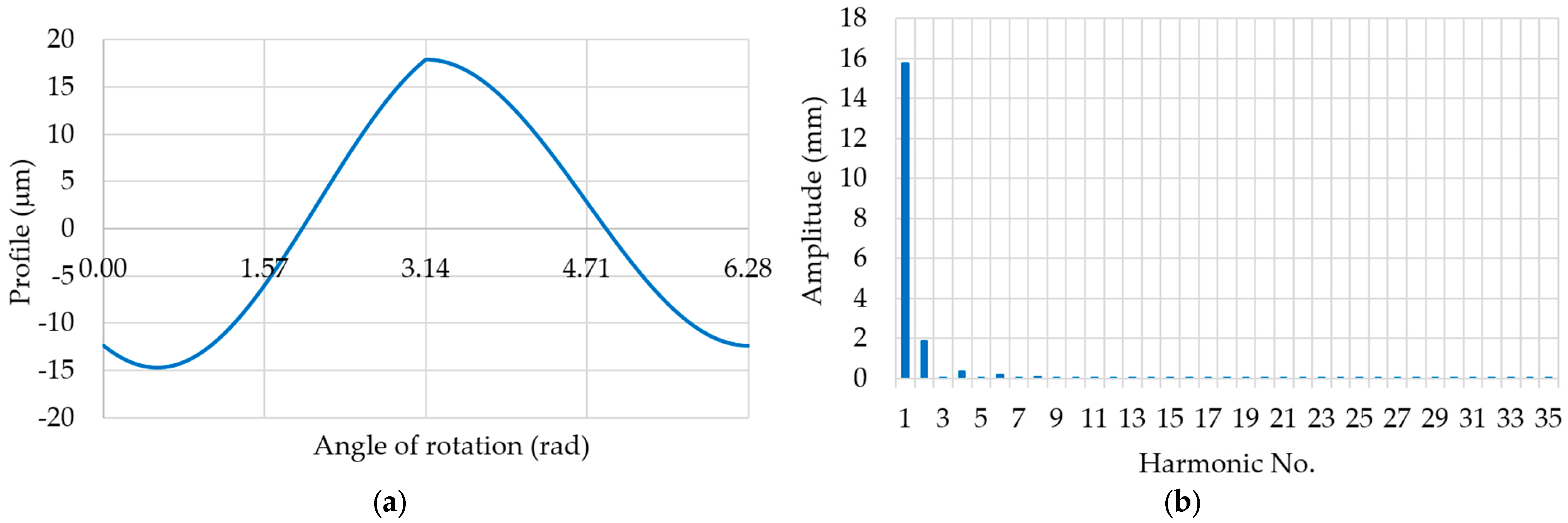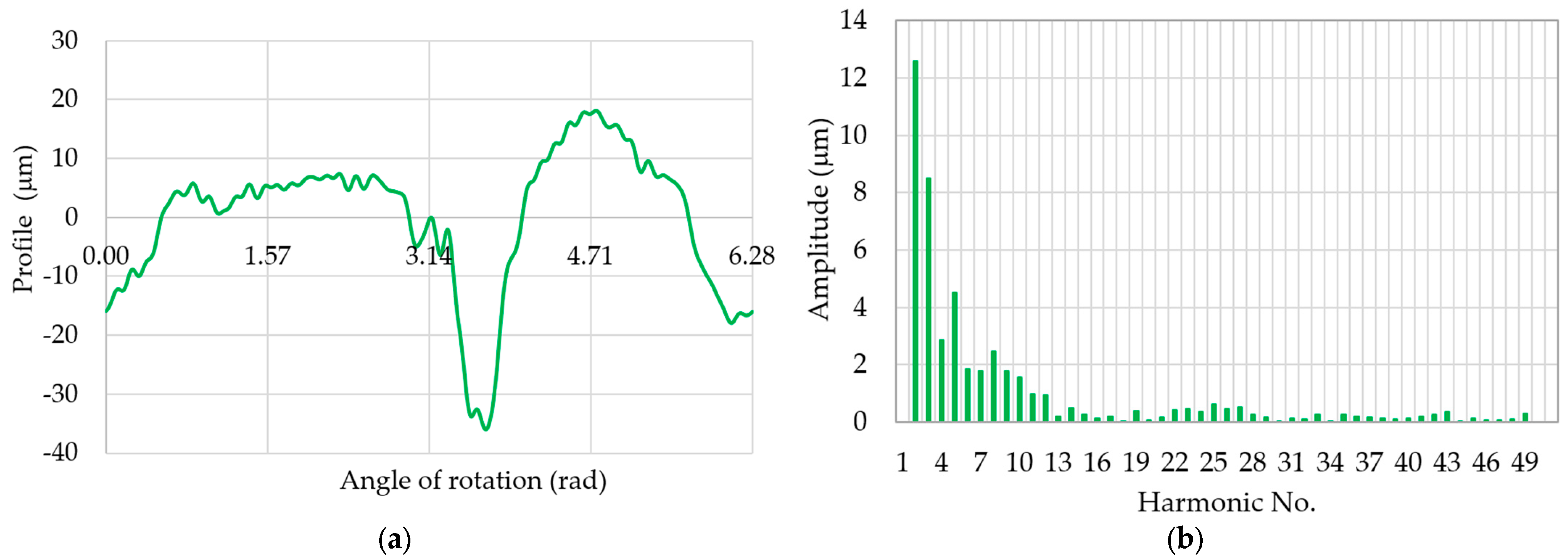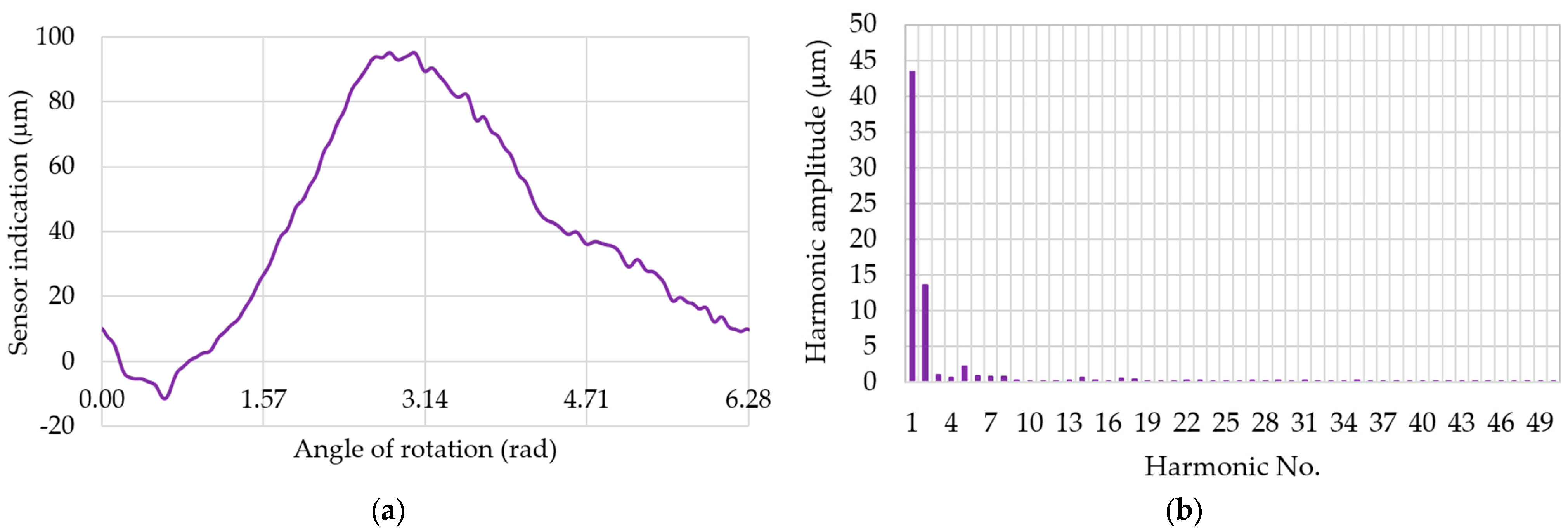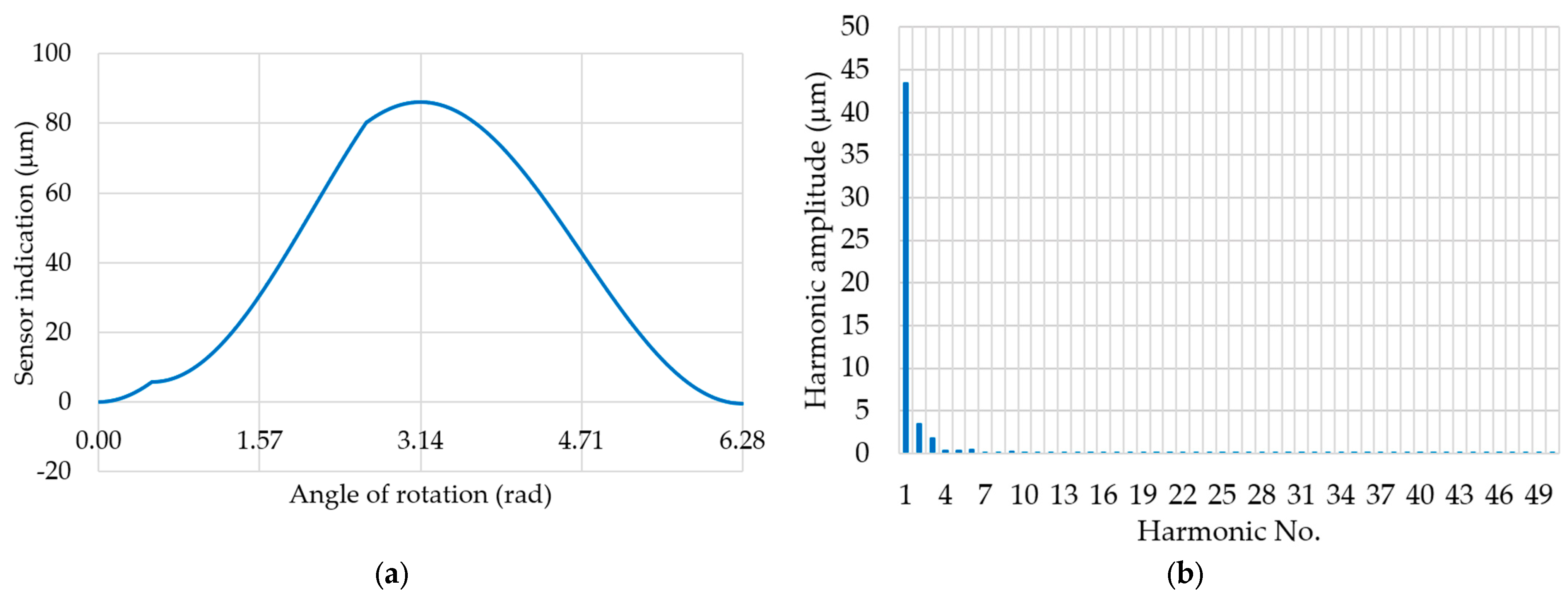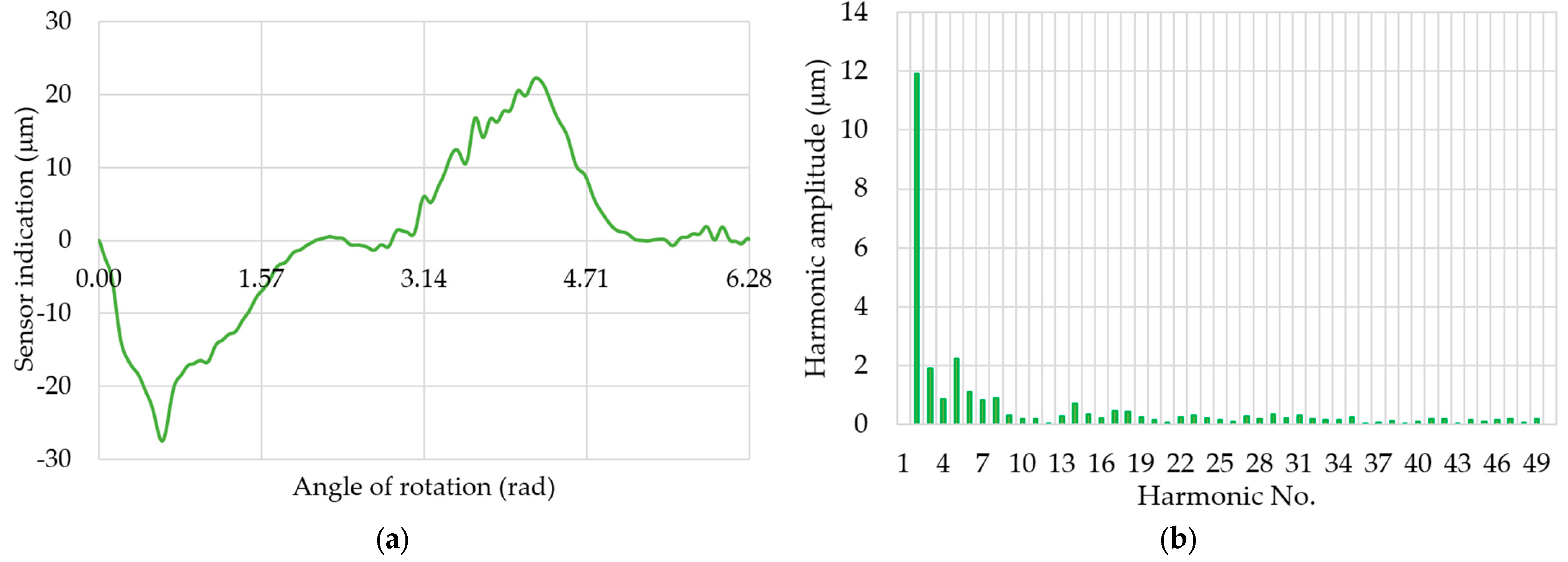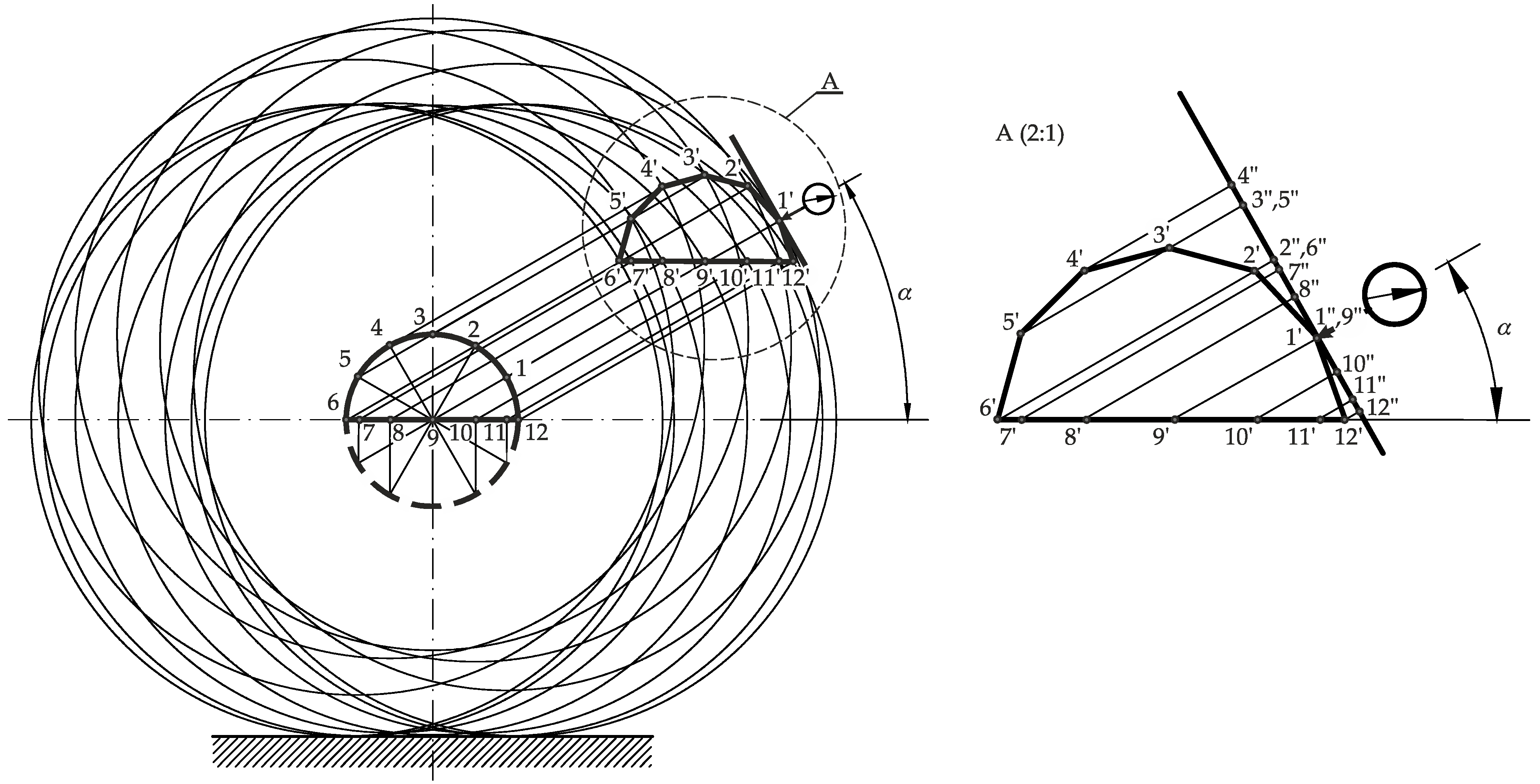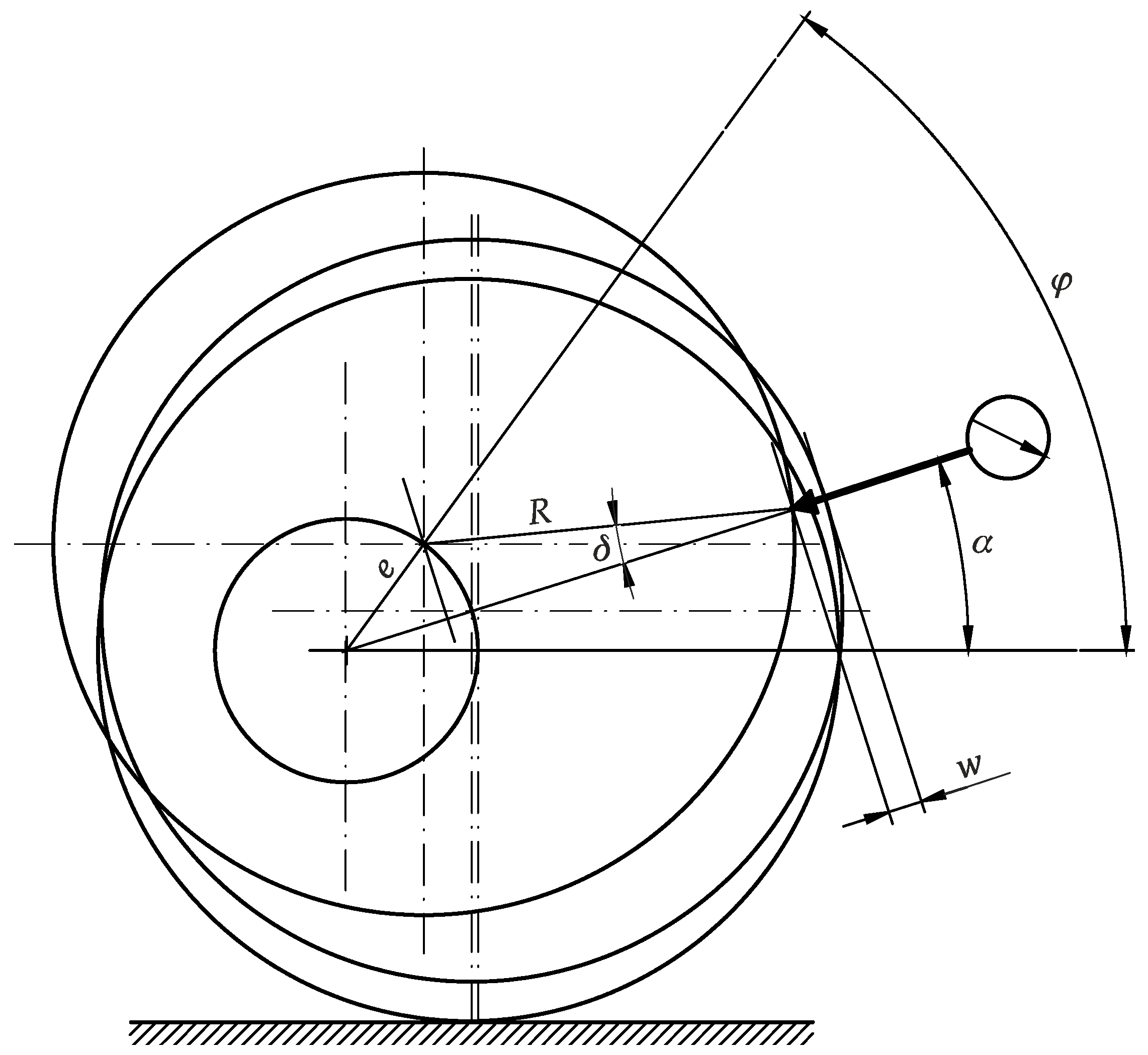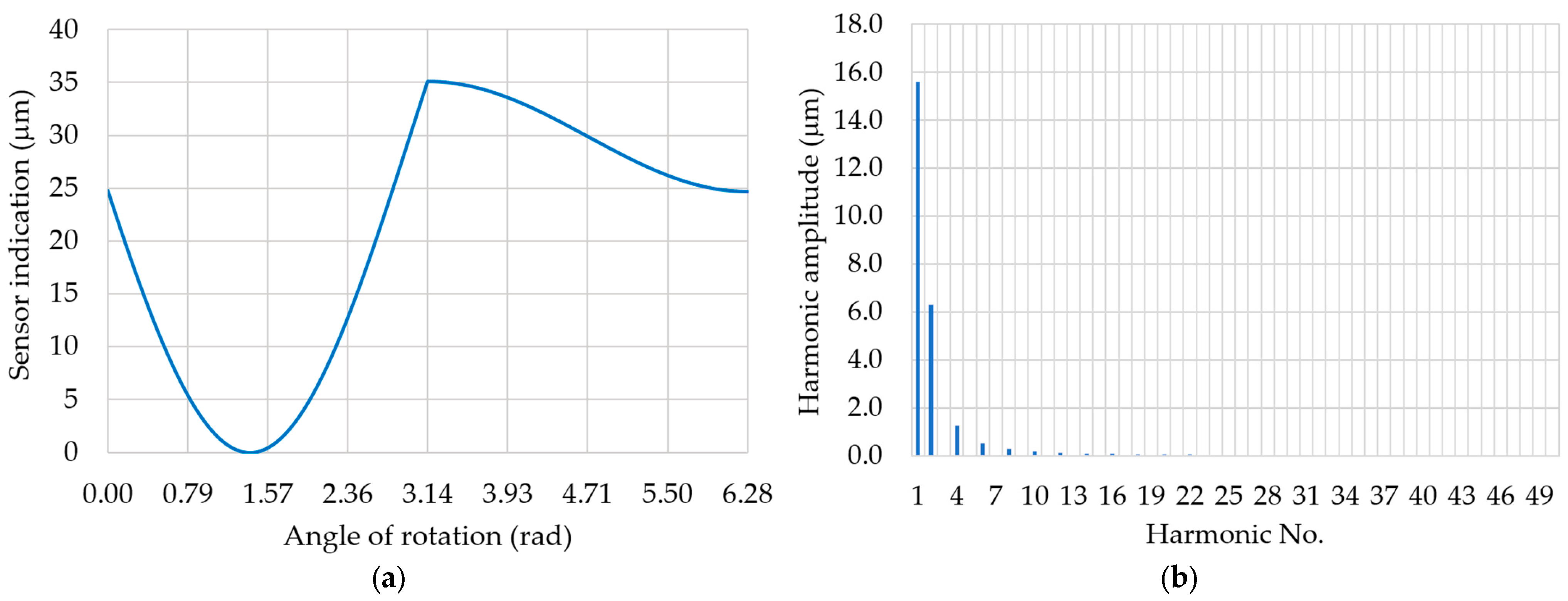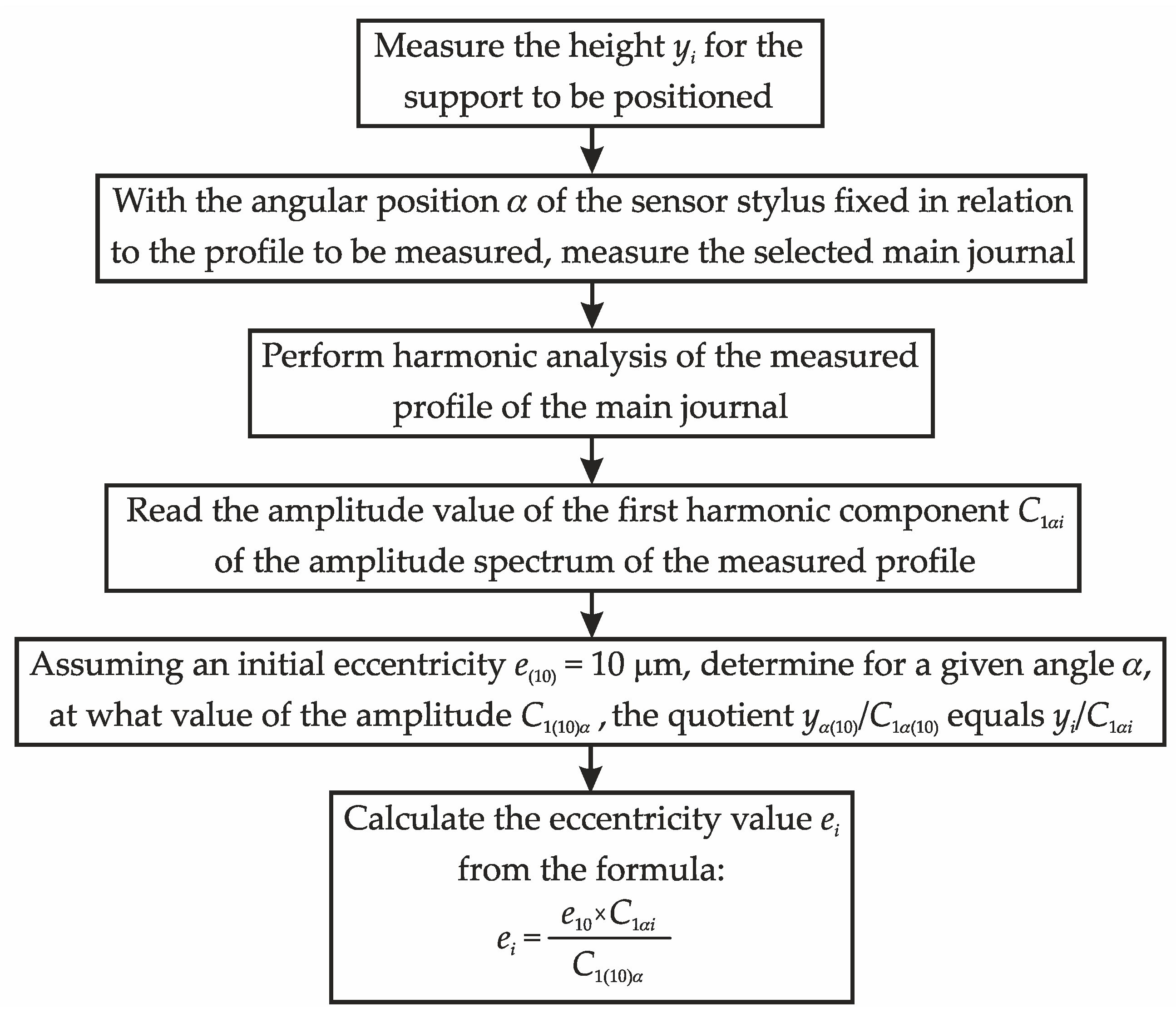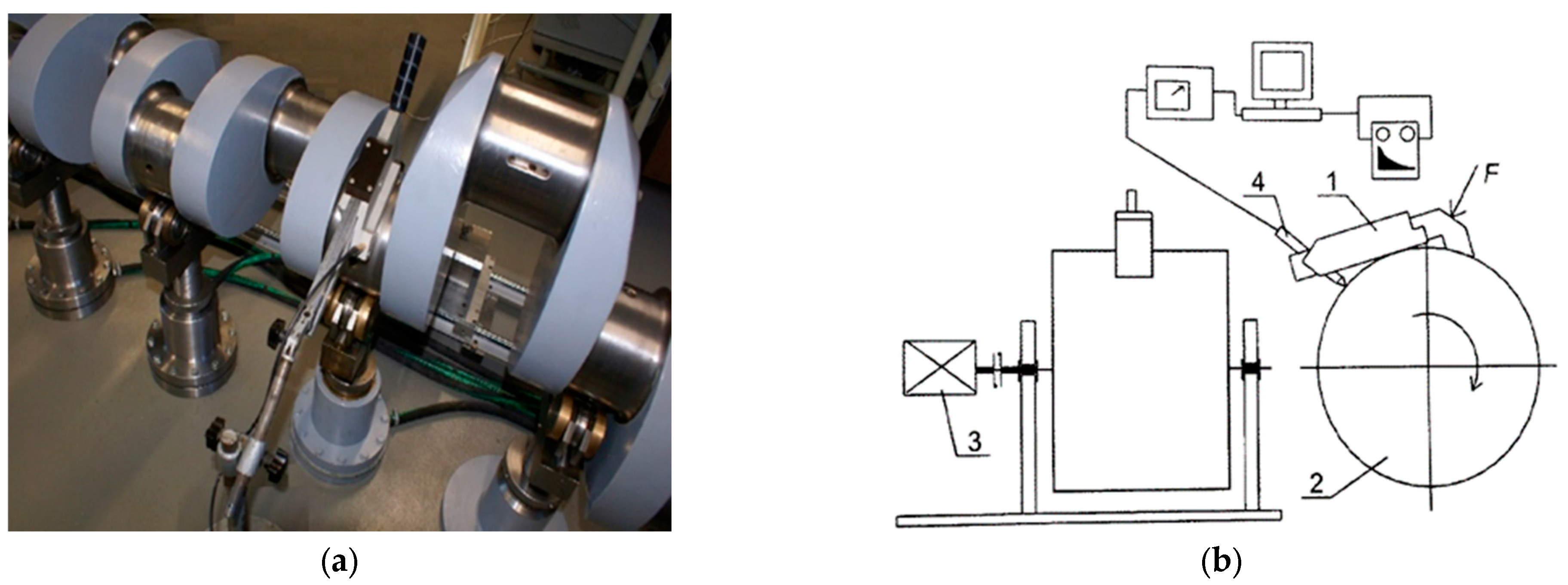1. Introduction
A characteristic feature of marine power plant machinery and equipment is the prevalence of large-size components. Among such machine elements, a specific group of parts characterised by low and variable stiffness and, consequently, high susceptibility to bending deformations can be distinguished. This group includes crankshafts of power engines of a ship’s main propulsion machinery as well as auxiliary engines and generator sets. The accuracy of crankshafts [
1,
2,
3,
4,
5] largely determines the correct functioning of the crank-piston system and, as a result, of the whole working machine [
6,
7,
8,
9].
With regard to crankshafts, high criteria are imposed in terms of geometrical execution, given in the product specifications. For this reason, the modern technological process of crankshafts requires constant quality control of the manufactured surfaces [
10]. A full and consistent assessment of the geometrical state of the product [
11] can be guaranteed only if measurement methods and techniques are used that allow their correct implementation from a metrological point of view, as well as instrumentation whose accuracy is adapted to the tolerances specified in the product specification.
Various methods for measuring and evaluating the circularity profiles of cylindrical machine components have been described in the literature. Mostly, however, they cannot be directly applied to the case of assessing the geometrical state of large-sized crankshafts. Generally, there are two methods of measuring circularity using either a rotary sensor instrument or a rotary table instrument [
2]. In the first method, the measured cylindrical element is stationary, and a sensor mounted in a special holder is rotated. In the second method, the measured cylindrical element turns (for example, on a rotary table), while the sensor remains stationary. The second method is simpler to implement. Examples of its use were described by Mekid and Vacharanukul [
12], who used a special probe with two laser beams to measure circularity, and by Liu et al. [
13], who applied an inductive sensor probe for the same purpose. The studies described in our paper were also carried out according to the second method but were performed for a full-scale large-size crankshaft.
The aforementioned papers deal with measuring the circularity of cylindrical surfaces. In contrast, in a paper published by Li et al. [
9] on measuring the diameter of the crankshaft of a 6-cylinder heavy-duty truck engine, a precise measurement method based on a dual-camera system is described. This system consists of two double telecentric lenses, two high-resolution cameras, and two telecentric back light sources. On the other hand, Pavlenko et al. [
14] presented a bench to determine the contour errors in the axial direction (such as obliquity, crowning and saddle shape) in the case of an agricultural tractor crankshaft. In a subsequent paper by Wang et al. [
15], a method of measuring and evaluating cylindricity error based on a step acceleration algorithm using a machine adapted to small crankshafts is described. The methods described in this paragraph refer to crankshafts fixed and unmoved on external journals [
9] or fixed in tusks on a measuring machine [
14,
15]. They therefore do not take into account the case of a crankshaft seated on supports, which is the subject of our paper.
One of the key issues during the machining of large-size crankshafts is the change in distance between adjacent crank arms. This phenomenon involves opening up the arms that connect two adjacent main journals to the corresponding connecting rod journal and is related to the flexibility of the shaft, its weight, and the fact that the axis of rotation does not correspond to the axis of the shaft. A prototype control support system for straightening elastic deformations of a bent crankshaft occurring due to this phenomenon during machining operations was described by Jeřábek et al. [
10]. An automatic alignment system integrated with a non-circular grinding machine for large-size crankshafts presented by Shen et al. [
7] operates on a similar principle. These methods concern the measurement of crankshafts during their machining. The method presented in our paper for evaluating the geometrical state of a crankshaft can be carried out under workshop conditions for a shaft after machining has been completed.
Taking into account the imposed accuracy requirements, it should be stated that a comprehensive description of the geometrical state of a crankshaft requires the determination of contour deviations and the no less important deviations of axis position. Due to unavoidable errors resulting from the technological process of machining, misalignment is an inherent element accompanying crankshaft measurement procedures [
15,
16,
17,
18,
19]. However, the resulting eccentric displacement of the main journals’ axes during the rotation of a measured crankshaft mounted on an assembly of rigid prism supports makes the evaluation of its geometrical state unreliable. This applies to both contour deviations and axis position deviations, as there are limits to the ability to detect geometrical deviations during measurements due to the support conditions adopted [
20,
21,
22], as demonstrated in the authors’ earlier papers [
23,
24,
25,
26].
The studies presented in the papers cited above did not take into account the influence of all the parameters of the measurement system on the results of measurements of geometrical magnitudes. In the case of crankshaft measurements based in prisms, the parameters of the measuring system include not only the adopted support conditions but also the parameters of the method.
The parameters of the method (characteristic for reference measurements of deviations and circularity profiles of cylindrical machine elements based in prisms) are defined as the angular magnitudes of the location of support points and measurement points in the adopted coordinate system [
27]. From a practical point of view, these magnitudes correspond successively to the opening angle of the fixing prisms 2
γ and the angle
α determining the direction of movement of the sensor stylus. Observations made during the implementation of previous studies suggested that changes in these parameters could significantly affect the final evaluation of crankshaft geometry. These suggestions have guided the direction of further work undertaken and implemented by our research team.
Taking into account that different method parameters may be used in practical measurements, the research problem required linking the change of method parameters to the developed procedures for determining geometrical deviations of the crankshaft with limited possibilities of their detection caused by the assumed conditions of its support. In particular, the research described here focused on evaluating the effect of the angle of sensor location on the results of measurements of geometrical magnitudes, changing the support conditions of the crankshaft. Two ways of supporting the shaft were adopted: on supports pre-positioned at an equal height and on supports pre-positioned at various heights. Details of the adopted assumptions, the research material, and the results of analysis in this regard are presented in this paper.
2. Materials and Methods
The case of measuring crankshaft main journals seated on supports pre-positioned at an equal height was considered first. The diagram shown in
Figure 1 was used to solve the problem adopted.
Figure 1 shows the characteristic points corresponding to the displacement of the tip of a sensor stylus measuring the eccentric displacement of a journal profile loaded with axial position deviation, during crankshaft rotation in 30° steps from 0° to 360°. The positioning of the direction of displacement of the sensor stylus relative to the measured profile is determined by the angle
α. The angle of crankshaft rotation is indicated by the parameter
φ, while the segment
e corresponds to the eccentricity (see
Figure 2). As shown, the displacement path of the sensor stylus tip is described by two segments. The first segment is described by an arc contained between points 1′ to 6′ and 12′ to 1′. The second is a rectilinear segment contained between points 6′ to 12′. The curved part of the displacement path corresponds to the measurement of the eccentric displacement of the journal when the journal was not in contact with the formers of the locating prism, where the measurements were not limited by the support of the journal. The rectilinear part of the displacement path corresponds to measurements limited by the journal support.
Based on the auxiliary diagrams shown successively in
Figure 2 and
Figure 3, mathematical relationships were then established linking the angular magnitude
α, which is one of the parameters of the method, with the record of the measured profile of the eccentric displacement of the journal loaded with axial position deviation. These relationships can be expressed by the following equations:
On the curved segment between points 1′ to 6′ and 12′ to 1′ (
Figure 2)
The measured parameter corresponding to the segment
w (shown in
Figure 2) can be described by the relation
On a straight segment between points 6′ and 12′ (
Figure 3)
Figure 3.
Auxiliary diagram adopted to determine the mathematical relationships linking the method parameter
α with the record of the measured eccentric displacement profile of the journal subjected to axial position deviation on the rectilinear segment, contained between the points 6′ to 12′ (illustrated in
Figure 1).
Figure 3.
Auxiliary diagram adopted to determine the mathematical relationships linking the method parameter
α with the record of the measured eccentric displacement profile of the journal subjected to axial position deviation on the rectilinear segment, contained between the points 6′ to 12′ (illustrated in
Figure 1).
Equations (1)–(5) are functional relationships enabling the measured eccentricity profile to be represented as a dependence of the change in angular position of the sensor stylus during crankshaft rotation. In accordance with the assumed interpretation of the geometrical features of the measured circularity profiles based on harmonic analysis, each profile can be represented as the sum of expressions of a trigonometric Fourier series, most commonly in the form of the so-called finite Fourier transform. The first expression of the Fourier series expansion of the function describing the measured profile corresponds to the axis position deviation, i.e., the eccentricity [
28,
29,
30,
31,
32,
33,
34,
35,
36]. Eliminating this component from the measured total profile allows the sum of the other components to be treated as theoretically corresponding to a record of the measured circularity profile.
However, the demonstrated limitation in the ability to detect geometrical deviations due to the support conditions adopted means that taking the first harmonic component as corresponding to eccentricity is a major simplification. Indeed, the eccentricity profile is in this case described by the sum of the harmonics. Characteristically, these are harmonics with even numbers. By eliminating the harmonics associated with the eccentricity profile from the discrete amplitude spectrum of the measured total profile, the harmonics associated with the real circularity profile of the examined journal can be selected.
Graphical interpretation of the formulated relationships allows the measured eccentric profile of the journal displacement to be represented over the full angle of rotation of the shaft from 0° to 360°. An example of such an interpretation for an assumed eccentricity of
e = 30 μm and a sensor stylus location angle of
α = 60° is shown in
Figure 4a. A discrete amplitude spectrum image corresponding to the presented eccentric journal displacement profile is shown in
Figure 4b. Changing the location angle of the sensor
α obviously varies the measured eccentric journal displacement profiles and, thus, the images of the amplitude spectrums.
Table 1 shows the values of the first harmonic amplitude spectra for an assumed eccentricity
e = 30 μm, with a change in 10° increments of the sensor location angle
α, within its practical application range of ±90°.
This table also lists the ratio between the successive values of the amplitudes of the first harmonics C1α when changing the angle α and the value of the amplitude of the harmonic component C1 = 30 μm, corresponding to the regular eccentricity profile e.
For any eccentricity
e, the proportions between the successive values of the harmonics
C1α and the value of
C1 equal to the full eccentricity
e remain constant. By expressing the successive harmonics
C1α in relative form, it is possible to make them independent of the specific value of eccentricity
e and to apply this interpretation in general form. Such an interpretation of the test results is shown in
Figure 5.
In order to determine the eccentricity
e, in the case of a deviated journal profile measurement, with the sensor stylus angled at
α to the profile to be measured and the supports positioned at an equal height, the algorithm presented in
Figure 6 can be used.
Figure 5.
Change in quotient C1α/C1 as a function of angle of rotation α.
Figure 5.
Change in quotient C1α/C1 as a function of angle of rotation α.
Figure 6.
Algorithm to determine the real eccentricity value ei from the known value of the amplitude of the first harmonic of the spectrum of the measured total journal profile C1αI and the angle α, for the case in which the supports are positioned at an equal height.
Figure 6.
Algorithm to determine the real eccentricity value ei from the known value of the amplitude of the first harmonic of the spectrum of the measured total journal profile C1αI and the angle α, for the case in which the supports are positioned at an equal height.
In the second case adopted for consideration, it was assumed that the supports to provide contact with the main journals were pre-positioned at various heights.
Based on the auxiliary diagrams shown in
Figure 7 and
Figure 8, mathematical relationships were determined for this case, linking the method parameter
α and the parameter
y representing the displacement of the support relative to the other supports maintaining the same height position, with the parameter
w representing the measured profile of the eccentric displacement of the journal subjected to the axial position deviation. These relationships can be expressed by the following formulas:
In the angle range
(
Figure 7)
The measured parameter
w can be described with the relation:
Figure 7.
Auxiliary diagram adopted to determine the mathematical relationships linking the method parameter α and the parameter y representing the offset of the support with respect to the other supports maintaining the same height position, with the parameter w representing the measured profile of the eccentric displacement of the journal subjected to the axial position deviation, within the angle range .
Figure 7.
Auxiliary diagram adopted to determine the mathematical relationships linking the method parameter α and the parameter y representing the offset of the support with respect to the other supports maintaining the same height position, with the parameter w representing the measured profile of the eccentric displacement of the journal subjected to the axial position deviation, within the angle range .
In the angle range
(
Figure 8)
The measured parameter
w can be described by the relation
The case adopted for consideration can be treated as a general one. A special version of this case is the case considered earlier, in which it was assumed that the supports were located at an equal height (
y = 0). For a given eccentricity
e and the support offset
y, which can be defined by measurements, the value of the amplitude of the first harmonic component
C1α, determined by harmonic analysis of the measured profile, is assigned. The course of the
C1α changes for eccentricity
e = 10 μm, with a change in support offset
y within ±10 μm and angle
α of ±90°, is shown in
Figure 9.
Figure 8.
Auxiliary diagram adopted to determine the mathematical relationships linking the method parameter α and the parameter y representing the offset of the support with respect to the other supports maintaining the same height position, with the parameter w representing the measured profile of the eccentric displacement of the journal subjected to the axial position deviation, within the angle range .
Figure 8.
Auxiliary diagram adopted to determine the mathematical relationships linking the method parameter α and the parameter y representing the offset of the support with respect to the other supports maintaining the same height position, with the parameter w representing the measured profile of the eccentric displacement of the journal subjected to the axial position deviation, within the angle range .
Additionally in this case, independently of the value of the full eccentricity
e, the ratio of the value of the support offset
y to the value of the amplitude of the first harmonic component of the measured circularity profile
C1α assumes a constant value. The course of the variation of the quotient
y/
C1α for eccentricity
e = 10 μm, with a change in support offset
y within ±10 μm and angle
α of ±90°, is shown in
Figure 10.
The quotient y/C1α has the property of being a universal parameter, enabling the true circularity profile to be determined from the total profile, measured in the direction of the sensor stylus displacement relative to the profile measured at an angle of α and the position of the support on which the eccentrically loaded journal under test is seated, with the displacement relative to the other journals by the magnitude of the parameter y.
Figure 9.
Change in C1α for eccentricity e = 10 μm, with a change in support offset y within ±10 μm and angle α of ±90°.
Figure 9.
Change in C1α for eccentricity e = 10 μm, with a change in support offset y within ±10 μm and angle α of ±90°.
Figure 10.
Change in quotient y/C1α for eccentricity e = 10 μm, with a change in support offset y within ±10 μm and angle α of ±90°.
Figure 10.
Change in quotient y/C1α for eccentricity e = 10 μm, with a change in support offset y within ±10 μm and angle α of ±90°.
The desired value of the eccentricity
e of the analysed profile can be determined taking into account that, when comparing the parameters of this profile with those of a profile with eccentricity
e10 = 10 μm, the following relation is valid:
In order to determine the eccentricity
e, in the case of measuring a journal profile subject to an axial deviation, with the sensor stylus at an angle
α to the profile to be measured and the support positioned at a height offset from the other supports by a value
y, a helpful calculation program was developed in the MATLAB environment. The algorithm of this program is shown in
Figure 11.
The calculation program developed can also be applied when the supports are positioned at an equal height, i.e., when y = 0.
